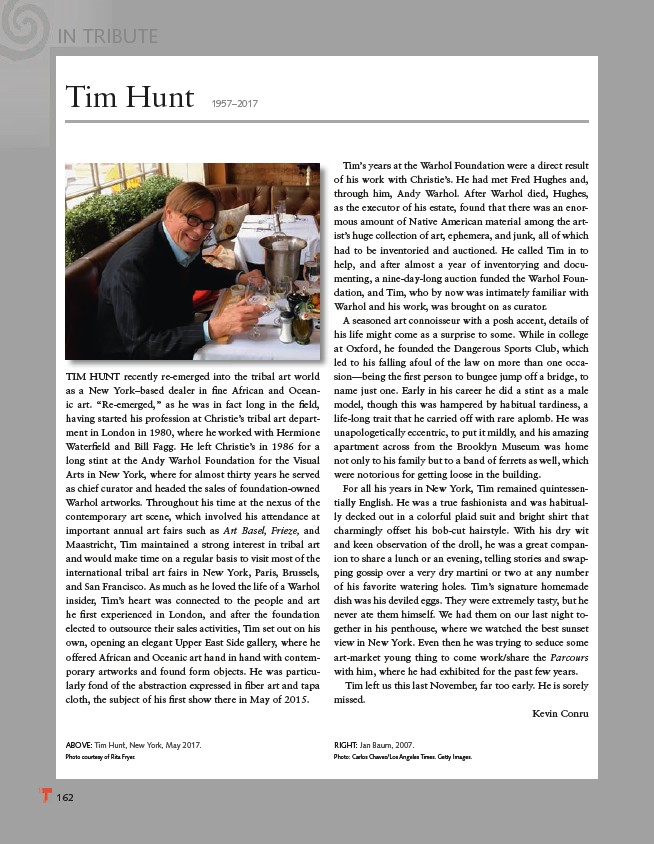
IN TRIBUTE
Tim Hunt 1957–2017
TIM HUNT recently re-emerged into the tribal art world
as a New York–based dealer in fi ne African and Oceanic
art. “Re-emerged,” as he was in fact long in the fi eld,
having started his profession at Christie’s tribal art department
162
in London in 1980, where he worked with Hermione
Waterfi eld and Bill Fagg. He left Christie’s in 1986 for a
long stint at the Andy Warhol Foundation for the Visual
Arts in New York, where for almost thirty years he served
as chief curator and headed the sales of foundation-owned
Warhol artworks. Throughout his time at the nexus of the
contemporary art scene, which involved his attendance at
important annual art fairs such as Art Basel, Frieze, and
Maastricht, Tim maintained a strong interest in tribal art
and would make time on a regular basis to visit most of the
international tribal art fairs in New York, Paris, Brussels,
and San Francisco. As much as he loved the life of a Warhol
insider, Tim’s heart was connected to the people and art
he fi rst experienced in London, and after the foundation
elected to outsource their sales activities, Tim set out on his
own, opening an elegant Upper East Side gallery, where he
offered African and Oceanic art hand in hand with contemporary
artworks and found form objects. He was particularly
fond of the abstraction expressed in fi ber art and tapa
cloth, the subject of his fi rst show there in May of 2015.
Tim’s years at the Warhol Foundation were a direct result
of his work with Christie’s. He had met Fred Hughes and,
through him, Andy Warhol. After Warhol died, Hughes,
as the executor of his estate, found that there was an enormous
amount of Native American material among the artist’s
huge collection of art, ephemera, and junk, all of which
had to be inventoried and auctioned. He called Tim in to
help, and after almost a year of inventorying and documenting,
a nine-day-long auction funded the Warhol Foundation,
and Tim, who by now was intimately familiar with
Warhol and his work, was brought on as curator.
A seasoned art connoisseur with a posh accent, details of
his life might come as a surprise to some. While in college
at Oxford, he founded the Dangerous Sports Club, which
led to his falling afoul of the law on more than one occasion—
being the fi rst person to bungee jump off a bridge, to
name just one. Early in his career he did a stint as a male
model, though this was hampered by habitual tardiness, a
life-long trait that he carried off with rare aplomb. He was
unapologetically eccentric, to put it mildly, and his amazing
apartment across from the Brooklyn Museum was home
not only to his family but to a band of ferrets as well, which
were notorious for getting loose in the building.
For all his years in New York, Tim remained quintessentially
English. He was a true fashionista and was habitually
decked out in a colorful plaid suit and bright shirt that
charmingly offset his bob-cut hairstyle. With his dry wit
and keen observation of the droll, he was a great companion
to share a lunch or an evening, telling stories and swapping
gossip over a very dry martini or two at any number
of his favorite watering holes. Tim’s signature homemade
dish was his deviled eggs. They were extremely tasty, but he
never ate them himself. We had them on our last night together
in his penthouse, where we watched the best sunset
view in New York. Even then he was trying to seduce some
art-market young thing to come work/share the Parcours
with him, where he had exhibited for the past few years.
Tim left us this last November, far too early. He is sorely
missed.
Kevin Conru
ABOVE: Tim Hunt, New York, May 2017.
Photo courtesy of Rita Fryer.
RIGHT: Jan Baum, 2007.
Photo: Carlos Chavez/Los Angeles Times. Getty Images.